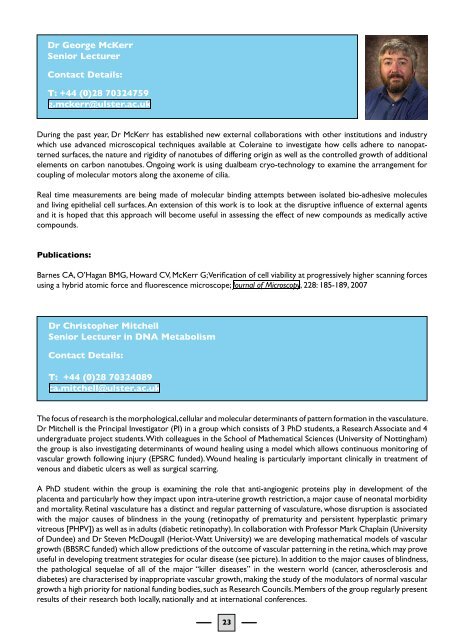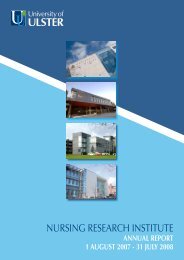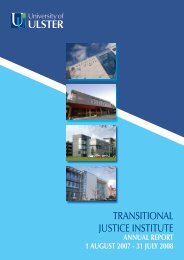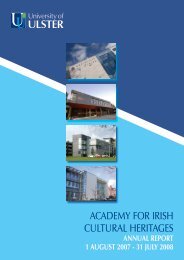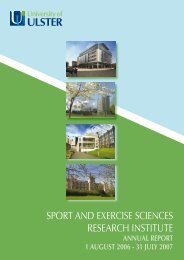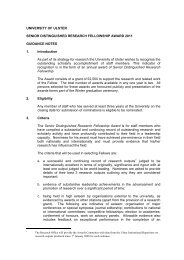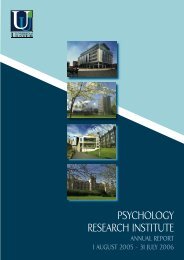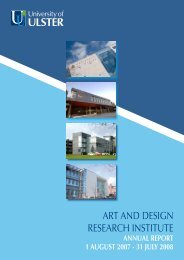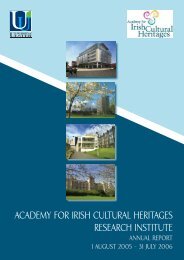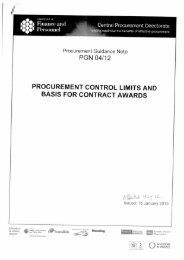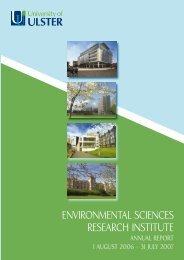developmental alterations that manifest during adulthood.Pr<strong>of</strong>essor Soto has been invited to speak about fetal causes <strong>of</strong> adult disease at several venues as speaker and consultant(international conferences, European Environmental Agency). She has also taught a section <strong>of</strong> the course directedby Pr<strong>of</strong>essor Howard entitled: Drug metabolism and Toxicology.Carcinogenesis/Tissue architecture:Dr Hendrik Fuss received training in 3D tissue culture at Pr<strong>of</strong>essor Soto’s Tufts laboratory and, on his return toColeraine, he was able to apply stereology techniques to the analysis <strong>of</strong> the epithelial structures present in these 3Dcultures. Unfortunately, Dr Fuss left us in November 2008. The efforts <strong>of</strong> this <strong>research</strong> resulted in us being invited tosubmit a proposal for the formation <strong>of</strong> a study group at The Centre for Mathematical Medicine and Biology (CMMB)at the <strong>University</strong> <strong>of</strong> Nottingham, as part <strong>of</strong> the interdisciplinary/integrative training activities <strong>of</strong> the Virtual PhysiologicalHuman Network <strong>of</strong> Excellence funded by the EU Framework Programme VII. Our project entitled “Tissuemorphogenesis: the case for tensegrity as a main determinant” was one <strong>of</strong> the five chosen for the June 2009 workshops.This training program is <strong>of</strong> national and international relevance, as it is aimed at advancing the use <strong>of</strong> mathematicaltools to the understanding <strong>of</strong> normal physiology and physiopathology.Publications:Maffini MV, Soto AM, Sonnenschein C, Papadopoulos N, Theoharides TC; Lack <strong>of</strong> c-kit receptor promotes mammarytumors in N-nitrosomethylurea-treated Ws/Ws rats; Cancer Cell Int. 2008, 8:5. [Epub ahead <strong>of</strong> print] PMID:18445266Krause, S, Maffini, MV, Soto, AM, Sonnenschein C; A novel 3D in vitro culture model to study stromal-epithelial interactionsin the mammary gland; Tissue Eng Part C Methods, 14: 261-271, 2008Vandenberg LN, Maffini MV, Schaeberle CM, Ucci AA, Sonnenschein C, Rubin BS, Soto AM; Perinatal exposure to thexenoestrogen bisphenol-A induces mammary intraductal hyperplasias in adult CD-1 mice; Reprod Toxicol, 26: 210-219,2008Soto AM, Vandenberg LN, Maffini MV and Sonnenschein C; Does breast cancer start in the womb? Basic Clin PharmacolToxicol., 102: 125-133, 2008Soto AM, Maffini MV, Sonnenschein C; Neoplasia as development gone awry: the role <strong>of</strong> endocrine disruptors; InternationalJournal <strong>of</strong> Androl. 31:288-93, 2008Sonnenschein C, Soto A; Theories <strong>of</strong> carcinogenesis: An emerging perspective; Semin Cancer Biol. 18: 372-377, 2008Soto AM, Sonnenschein C, Miquel PA; On physicalism and downward causation in developmental and cancer biology;Acta Biotheoretica, 56: 257-274, 2008Crain DA, Janssen SJ, Edwards TM, Heindel J, Ho SM, Hunt P, Iguchi T, Juul A, McLachlan JA, Schwartz J, Skakkebaek N,Soto AM, Swan S, Walker C, Woodruff TK, Woodruff TJ, Giudice LC, Guillette LJ Jr; Female reproductive disorders: theroles <strong>of</strong> endocrine-disrupting compounds and developmental timing; Fertil Steril, 90: 911-940, 2008Soto AM, Rubin BS, Sonnenschein C; Interpreting endocrine disruption from an integrative biology perspective; MolCell Endocrinol. (in press)22
Dr George McKerrSenior LecturerContact Details:T: +44 (0)28 70324759g.mckerr@ulster.ac.ukDuring the past year, Dr McKerr has established new external collaborations with other institutions and industrywhich use advanced microscopical techniques available at Coleraine to investigate how cells adhere to nanopatternedsurfaces, the nature and rigidity <strong>of</strong> nanotubes <strong>of</strong> differing origin as well as the controlled growth <strong>of</strong> additionalelements on carbon nanotubes. Ongoing work is using dualbeam cryo-technology to examine the arrangement forcoupling <strong>of</strong> molecular motors along the axoneme <strong>of</strong> cilia.Real time measurements are being made <strong>of</strong> molecular binding attempts between isolated bio-adhesive moleculesand living epithelial cell surfaces. An extension <strong>of</strong> this work is to look at the disruptive influence <strong>of</strong> external agentsand it is hoped that this approach will become useful in assessing the effect <strong>of</strong> new compounds as medically activecompounds.Publications:Barnes CA, O’Hagan BMG, Howard CV, McKerr G; Verification <strong>of</strong> cell viability at progressively higher scanning forcesusing a hybrid atomic force and fluorescence microscope; Journal <strong>of</strong> Microscopy, 228: 185-189, 2007Dr Christopher MitchellSenior Lecturer in DNA MetabolismContact Details:T: +44 (0)28 70324089ca.mitchell@ulster.ac.ukThe focus <strong>of</strong> <strong>research</strong> is the morphological, cellular and molecular determinants <strong>of</strong> pattern formation in the vasculature.Dr Mitchell is the Principal Investigator (PI) in a group which consists <strong>of</strong> 3 PhD students, a <strong>Research</strong> Associate and 4undergraduate project students. With colleagues in the School <strong>of</strong> Mathematical Sciences (<strong>University</strong> <strong>of</strong> Nottingham)the group is also investigating determinants <strong>of</strong> wound healing using a model which allows continuous monitoring <strong>of</strong>vascular growth following injury (EPSRC funded). Wound healing is particularly important clinically in treatment <strong>of</strong>venous and diabetic ulcers as well as surgical scarring.A PhD student within the group is examining the role that anti-angiogenic proteins play in development <strong>of</strong> theplacenta and particularly how they impact upon intra-uterine growth restriction, a major cause <strong>of</strong> neonatal morbidityand mortality. Retinal vasculature has a distinct and regular patterning <strong>of</strong> vasculature, whose disruption is associatedwith the major causes <strong>of</strong> blindness in the young (retinopathy <strong>of</strong> prematurity and persistent hyperplastic primaryvitreous [PHPV]) as well as in adults (diabetic retinopathy). In collaboration with Pr<strong>of</strong>essor Mark Chaplain (<strong>University</strong><strong>of</strong> Dundee) and Dr Steven McDougall (Heriot-Watt <strong>University</strong>) we are developing mathematical models <strong>of</strong> vasculargrowth (BBSRC funded) which allow predictions <strong>of</strong> the outcome <strong>of</strong> vascular patterning in the retina, which may proveuseful in developing treatment strategies for ocular disease (see picture). In addition to the major causes <strong>of</strong> blindness,the pathological sequelae <strong>of</strong> all <strong>of</strong> the major “killer diseases” in the western world (cancer, atherosclerosis anddiabetes) are characterised by inappropriate vascular growth, making the study <strong>of</strong> the modulators <strong>of</strong> normal vasculargrowth a high priority for national funding bodies, such as <strong>Research</strong> Councils. Members <strong>of</strong> the group regularly presentresults <strong>of</strong> their <strong>research</strong> both locally, nationally and at international conferences.23
- Page 1: BIOMEDICAL SCIENCESRESEARCH INSTITU
- Page 4 and 5: 1 Foreword by the Pro Vice-Chancell
- Page 6 and 7: 2 Foreword by the Research Institut
- Page 8 and 9: The BMSRI Research StructureThe BMS
- Page 10 and 11: BMSRI Core FacilitiesContact: Karen
- Page 12 and 13: of Metabolomics, pharmacy, nutritio
- Page 14 and 15: BMSRI Academic Heads new Regional N
- Page 16 and 17: 4. BIOMEDICAL GENOMICS RESEARCH GRO
- Page 18 and 19: Recent Funding Initiatives:C-TRIC:
- Page 20 and 21: Dr Mateus Webba da SilvaLecturer in
- Page 22 and 23: 5. BIOIMAGING RESEARCH GROUPResearc
- Page 26 and 27: Publications:Bigot S, Lucas L, Morr
- Page 28 and 29: Publications:Barnes CA, O’Hagan B
- Page 30 and 31: We also measure the genotoxic effec
- Page 32 and 33: 6. CANCER AND AGEING RESEARCH GROUP
- Page 34 and 35: Professor Anthony P McHaleProfessor
- Page 36 and 37: Professor Stephanie McKeownProfesso
- Page 38 and 39: an Alzheimer Research Trust collabo
- Page 40 and 41: JM, Waugh DJJ; Dexamethasone potent
- Page 42 and 43: have wider applications in vivo, in
- Page 44 and 45: Inter-relationships between diet an
- Page 46 and 47: Flatt PR; Effective surgical treatm
- Page 48 and 49: These areas are the subject of seve
- Page 50 and 51: Dr YHA Abdel-WahabSenior Lecturer i
- Page 52 and 53: Dr VA GaultLecturer in Molecular Bi
- Page 54 and 55: McClean PL, Irwin N, Hunter K, Gaul
- Page 56 and 57: Publications:Duffy NA, Green BD, Ir
- Page 58 and 59: 8. MICROBIOLOGY AND BIOTECHNOLOGYRE
- Page 60 and 61: Publications:Graham RJL, Graham C,
- Page 62 and 63: analyses. However there is still a
- Page 64 and 65: Plessas S, Bekatorou A, Koutinas AA
- Page 66 and 67: Biochemical studies/ viral evasion
- Page 68 and 69: Dr Stephen McCleanLecturer in Prote
- Page 70 and 71: environmental remediation and as ro
- Page 72 and 73: 9. NORTHERN IRELAND CENTRE FOR FOOD
- Page 74 and 75:
26-28 Sept 2007: International Seaf
- Page 76 and 77:
Dr Barnes has developed expertise i
- Page 78 and 79:
Dr Alison GallagherSenior Lecturer
- Page 80 and 81:
In addition, results of a pilot stu
- Page 82 and 83:
Dr Maeve KerrResearch AssociateCont
- Page 84 and 85:
Memberships of External Committees/
- Page 86 and 87:
Indicators of Esteem:Professor McNu
- Page 88 and 89:
were examined. The intervention and
- Page 90 and 91:
Within this work both short-term an
- Page 92 and 93:
micronutrient supplementation at a
- Page 94 and 95:
10. STEM CELL & EPIGENETICS RESEARC
- Page 96 and 97:
Publications:Lees-Murdock DJ, Lau H
- Page 98 and 99:
Publications:Lees-Murdock DJ, Lau H
- Page 100 and 101:
11. SYSTEMS BIOLOGY RESEARCH GROUPT
- Page 102 and 103:
Kravtsov V, Swain M, Schuster A, Du
- Page 104 and 105:
Dr Daniel BerrarLecturer in Biomedi
- Page 106 and 107:
Zhang et al; Incorporating Feature
- Page 108 and 109:
Bala P, Baldridge K, Benfenati E, C
- Page 110 and 111:
In addition there is a growing them
- Page 112 and 113:
Clinical work involves development
- Page 114 and 115:
In 2009 he was appointed Chairman o
- Page 116 and 117:
Stevenson TR, Goodall EA and Moore
- Page 118 and 119:
Dr Raymond BeirneLecturer in Optome
- Page 120 and 121:
Dr Julie McClellandLecturer in Opto
- Page 122 and 123:
Graham JE, Moore JE, Moore JE, McCl
- Page 124 and 125:
Research Staff:Dr David OrrSenior R
- Page 126 and 127:
Dr Victoria McGilliganResearch Asso
- Page 128 and 129:
13. Externally Funded Projects duri
- Page 130 and 131:
Grant Holder Anderson, Prof RSFundi
- Page 132 and 133:
Funding Body Royal Irish AcademyAmo
- Page 134 and 135:
14. BIOMEDICAL SCIENCES RESEARCH IN
- Page 136 and 137:
Student: Simon GenglerTitle: Effect
- Page 138 and 139:
Student: Anisha MazumdarTitle: Anal
- Page 140 and 141:
Student: Clare RyanTitle: How does
- Page 142 and 143:
CONGRATULATIONS TO THE FOLLOWING PO


